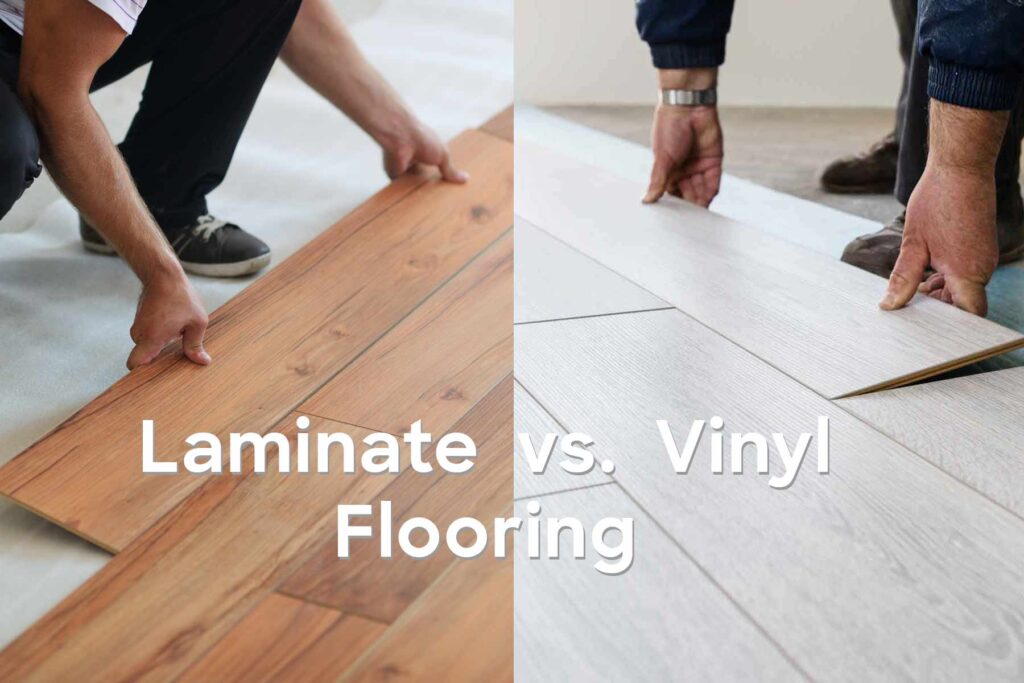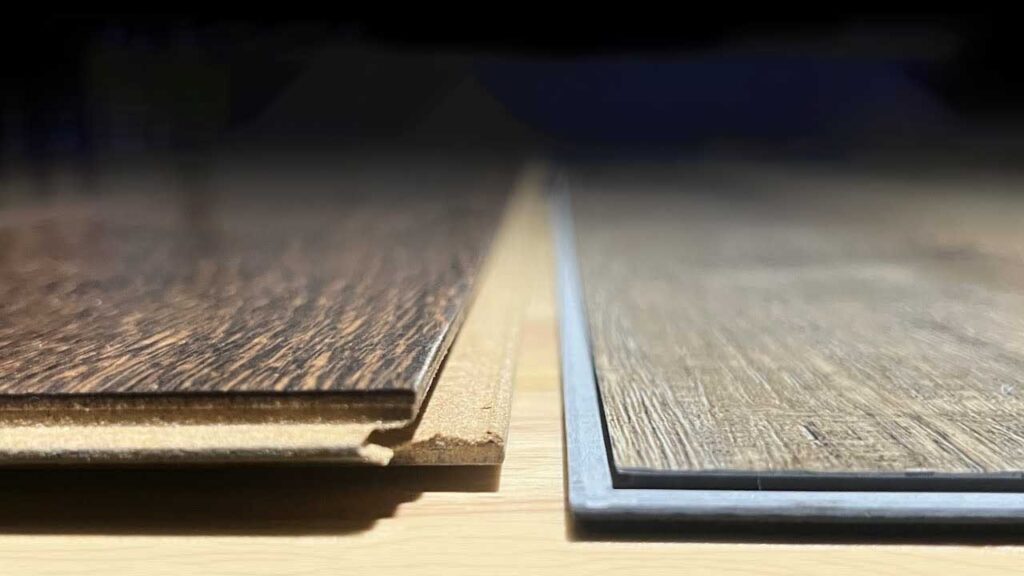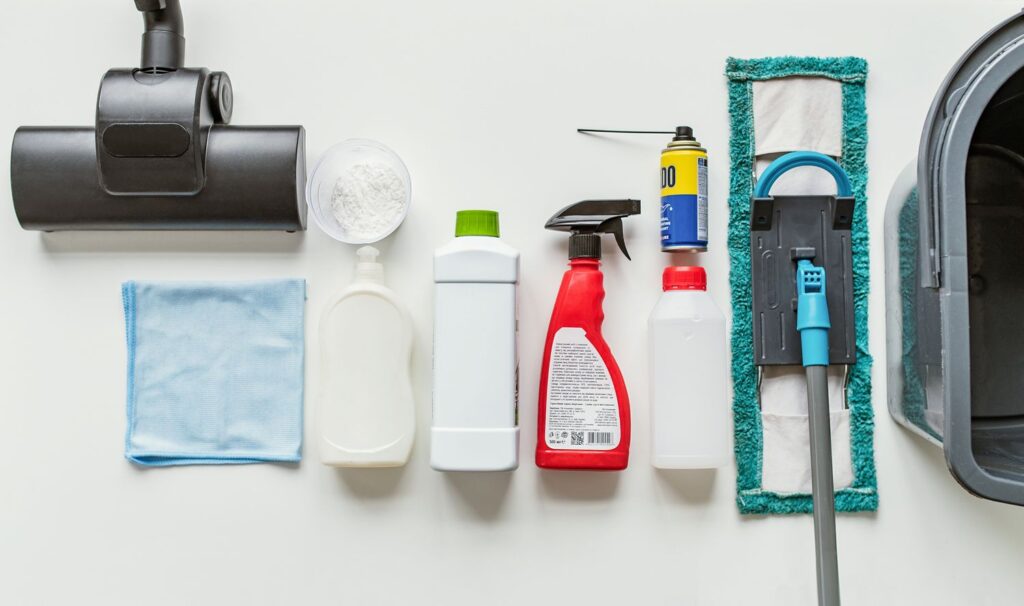
If you’re planning to refresh your floors and can’t decide between vinyl and laminate, you’re not alone. These two popular options are known for delivering big style at a fraction of hardwood’s cost. But what sets them apart? Which one handles kids spilling juice, pets running around, or the everyday hustle and bustle better? And which one will keep you happiest in the long run? Let’s dive into an in-depth comparison—complete with handy tables and real-life insights—so you can pick the perfect floor for your home.
Vinyl and laminate both offer budget-friendly, stylish flooring choices. Vinyl is typically more water-resistant and durable, making it great for kitchens or bathrooms. Laminate, with its wood-based core, often provides a more authentic “wood feel.” Deciding factors include moisture levels, foot traffic, budget, and desired aesthetic.
Imagine hosting friends in your freshly renovated living room, the floors gleaming under soft lighting. They ask, “Is this hardwood?” You smile because your vinyl or laminate floors look and feel so realistic that they can’t tell the difference. By the end of this guide, you’ll know exactly which material will let you enjoy that moment—without stressing about spills or scratches.
I. Introduction: What Are Vinyl and Laminate Floors?
Vinyl and laminate are synthetic flooring solutions that mimic real wood or stone. Vinyl is made predominantly from PVC, offering strong moisture resistance, while laminate combines a wood-fiber core with a photo-realistic surface for a warm, natural appearance.

Origins, Popularity, and Core Differences
- A Brief History
- In vinile: Gained traction in the mid-1900s as a cheaper, more resilient alternative to older materials like linoleum. Technological advancements led to improved visuals and greater water resistance, solidifying vinyl’s place in both homes and commercial spaces.
- Laminato: Introduced in the 1970s, laminate quickly became the go-to for homeowners craving a hardwood look minus the hefty price tag. Over time, enhancements like embossed-in-register (EIR) textures made it nearly indistinguishable from real wood in appearance.
- Why Everyone’s Talking About Them
- Costo-efficacia: Both are more wallet-friendly than hardwood or stone, yet can replicate those premium looks fairly convincingly.
- Varietà di design: From rustic oak to sleek marble, you’ll find endless patterns, colors, and finishes.
- Facilità di installazione: With click-lock systems, many DIY enthusiasts can tackle installing these floors over a weekend, especially in smaller rooms.
- Differenze fondamentali
- Composizione: Vinyl is entirely synthetic, typically multiple PVC layers. Laminate uses a wood-based core sandwiched by a decorative layer and wear layer.
- Resistenza all'umidità: Vinyl typically outperforms laminate when it comes to water.
- Feel Underfoot: Laminate often feels a bit “warmer” or more like natural wood, especially with a good underlayment.
- Where They Fit Best
- In vinile: Kitchens, bathrooms, basements—moisture-heavy or high-traffic zones.
- Laminato: Living rooms, bedrooms, or drier areas of the house where you want a cozy, real-wood vibe without hardwood’s high cost.
If you’re seeking a blend of budget-friendliness, durability, and a dash of elegance, vinyl and laminate certainly deserve a close look. The next sections will break down exactly how they differ in durability, water resistance, and more, so let’s keep going.
II. How Do Vinyl and Laminate Differ in Composition and Durability?
Vinyl typically features layered PVC construction, making it highly resistant to water and wear. Laminate, built around a wood-fiber core, is prone to swelling if exposed to moisture but can still be very durable in lower-humidity environments.
“What Lasts Longer, Vinyl or Laminate Flooring?”
- Layer-by-Layer Breakdown
- In vinile
- Strato di usura: Protects against scratches, stains, and everyday wear.
- Strato stampato: Supplies the design—wood grain, stone, tile patterns.
- Strato centrale: Can be flexible PVC or a more rigid stone-plastic composite (SPC).
- Laminato
- Strato di usura: A transparent, protective overlay.
- Decor Layer: A high-definition image simulating wood or stone.
- HDF (High-Density Fiberboard) Core: This wood-fiber core is relatively strong but not waterproof.
- In vinile
- Traffic-Handling Power
- In vinile: Often praised for withstanding heavy foot traffic in hallways or retail spaces without losing its shine—especially thicker options (4–6mm+).
- Laminato: Premium laminate (8–12mm thick) handles moderate to heavy traffic nicely, though repeated abuse might reveal scratches or dents faster than vinyl.
- Resistenza ai graffi e alle ammaccature
- In vinile: Synthetic composition often makes it a bit more forgiving. Rigid-core vinyl (SPC/WPC) is particularly dent-resistant.
- Laminato: The protective top layer wards off minor scuffs, but dragging furniture or dropping heavy objects can leave marks.
- Water Woes
- In vinile: Generally labeled as waterproof or water-resistant. Occasional spills or even small floods are less catastrophic.
- Laminato: Water is its kryptonite. Quick cleanups are fine, but letting liquid pool on the surface can lead to swelling or buckling.
- Longevity Stats
- In vinile: Well-maintained vinyl can last 15–20 years or more. Some commercial-grade options stretch beyond that.
- Laminato: Typically 10–15 years, though high-end products can rival vinyl if well cared for.
Durability Comparison Table
| Aspetto | Pavimenti in vinile | Pavimento in laminato |
|---|---|---|
| Materiale del nucleo | PVC or Stone-Plastic Composite (SPC) | High-Density Fiberboard (HDF) |
| Resistenza all'acqua | Excellent; often labeled “waterproof” | Limited; prone to swelling if water infiltrates |
| Resistenza ai graffi | Good to excellent (thicker wear layers do better) | Decent; heavy abuse can show scuffs & dents |
| Durata di vita tipica | ~15–20+ years (high-quality) | ~10–15 years (premium range) |
| Casi d'uso ideali | Bathrooms, kitchens, basements, commercial spaces | Living rooms, bedrooms, lower-humidity areas |
When it comes to raw durability—especially around moisture—vinyl often comes out on top. But does that automatically mean vinyl is better for everyone? Let’s explore the complexities of that question next.
III. Is Vinyl Flooring Better Than Laminate?
There’s no universal “better” floor. Vinyl boasts stronger water resistance, while laminate provides a more organic wood feel. Your choice depends on factors like budget, style preference, and how much moisture or heavy traffic your floor will face.

Bilanciare i pro e i contro
- Water Worries vs. Wood Warmth
- In vinile: If you’re the type who hates worrying about spills—maybe you have pets or lively kids—vinyl’s water resistance might be priceless.
- Laminato: Offers that “wood-like” warmth underfoot. In a cozy living room or bedroom, laminate can shine, as moisture concerns are often minimal.
- Considerazioni sull'installazione
- In vinile: Click-lock vinyl is quite DIY-friendly, and even glue-down vinyl can be straightforward if you carefully prep the subfloor.
- Laminato: Also typically uses a click-lock system. However, ensuring a perfectly level subfloor is crucial to avoid squeaky spots.
- Feel Underfoot
- In vinile: Can feel softer or more cushioned, especially if it has an attached underlayment.
- Laminato: May produce a “hollow” tapping sound if underlayment is too thin or subfloor issues exist, but it can also feel pleasantly warm.
- Aesthetic and Authenticity
- In vinile: High-end designs can look incredibly realistic, though cheaper vinyl may appear too shiny or repetitive in pattern.
- Laminato: Known for exceptional woodgrain detail. Some premium laminates make it tough to distinguish from real hardwood.
- Health and Environmental Factors
- In vinile: May emit volatile organic compounds (VOCs) unless it’s certified low-VOC. The PVC production process also has an environmental footprint.
- Laminato: Fiberboard cores can contain formaldehyde; reputable brands meet strict emissions standards to limit off-gassing.
If your top priority is zero stress about water damage, vinyl is probably worth the investment. But if you’re partial to a wood-like texture underfoot, and your space doesn’t face moisture threats, laminate might make you happier.
IV. Which Installation Methods Work Best for Each Type?
Both materials commonly use a click-lock floating method, ideal for DIY projects. Vinyl can also be glued down or peel-and-stuck, offering extra stability in commercial or high-traffic areas. Laminate rarely uses glue and generally relies on floating installs.
Navigating Installation Options
- Click-Lock Floating Floors
- In vinile
- Process: Align planks, angle, and click them into place. Typically straightforward.
- Preparazione del sottofondo: Must be clean, level, and dry. Minimal adhesives needed.
- Laminato
- Spazi di espansione: Leave a small gap around the room perimeter to allow the floor to expand or contract with humidity changes.
- Sottofondo: Often needed for comfort, sound reduction, and moisture control (especially over concrete).
- In vinile
- Installazione a colla
- In vinile
- Why Glue?: Great for large or commercial spaces where you don’t want any shifting.
- Adhesive Quality: Ensure it’s compatible with vinyl. Some adhesives add waterproofing benefits or stronger bonds.
- Laminato
- Less Common: Most laminate floors are designed as floating systems. Glue-down laminate is rare and more labor-intensive.
- In vinile
- Vinile adesivo
- Budget & Convenience: Quick to install, suitable for small areas like laundry rooms or half-baths.
- Durability Caveat: Can wear out faster than thicker click-lock or glue-down options, but easy to replace individual tiles.
- DIY or Pro?
- DIY: If you’re handy, floating floors are often manageable. Just be sure to measure carefully and follow leveling instructions.
- Professional: For big commercial projects or intricate layouts (lots of corners or transitions), hiring a pro ensures a seamless look and might preserve your warranty.
- Subfloor Essentials
- Clean & Level: Both vinyl and laminate rely on a stable foundation to prevent squeaks or lumps.
- Barriera anti-umidità: Especially recommended for laminate over concrete or in humid areas.
Bottom line: if you’re new to home improvement, start with a floating click-lock system—whether vinyl or laminate—for an easier learning curve.
V. Is Water Resistance a Deciding Factor in the Vinyl vs Laminate Debate?
Yes. Vinyl’s waterproof nature makes it ideal for rooms prone to spills or humidity, whereas laminate risks swelling if water lingers. Many homeowners choose vinyl specifically for bathrooms, kitchens, or basements where moisture is unavoidable.
Where Water Really Matters
- Bagni e cucine
- In vinile: Resists splashes, steam, and even small floods if installed correctly. Perfect for these splash zones.
- Laminato: Functions fine for everyday cooking or occasional splash, but a major leak could cause serious damage.
- Scantinati e lavanderie
- Basement Humidity: Basements often deal with high humidity or minor leaks. Vinyl’s synthetic core adapts better to these conditions.
- Laundry Mishaps: Overflowing washing machines aren’t kind to laminate. Vinyl, on the other hand, can handle the occasional water overflow more gracefully.
- Outdoor-Adjacent Areas
- Mudrooms, Sunrooms: Dirty shoes, fluctuating temperatures, and potential moisture infiltration can test laminate’s tolerance. Vinyl’s easier to maintain here.
- Patio Door Entrances: If you have a door leading directly outside, vinyl’s easier to wipe clean from muddy footprints or wet paws.
- Long-Term Upkeep
- Laminate Precaution: Quick spill cleanups are fine, but watch out for standing water around fridge leaks, dripping AC units, or plumbing mishaps.
- Vinyl Confidence: You can rest easier with vinyl, as typical day-to-day moisture won’t cause panic.
- Cost vs. Performance
- Vinyl Price: High-end, 100% waterproof vinyl might cost more upfront, but could save you from expensive replacements if water damage occurs.
- Laminate Bargains: If you’re not dealing with water issues, laminate’s cost savings might appeal.
For a lot of folks, water resistance is the “tie-breaker.” If water exposure is a real concern in your home, vinyl usually steals the show.
VI. What Are the Key Maintenance and Cleaning Requirements?
Both floors benefit from regular sweeping or vacuuming. Vinyl tolerates damp mopping more gracefully; laminate requires caution with moisture. Avoid harsh chemicals or abrasive brushes on either to prolong their finish.

Everyday Upkeep for Each Flooring Type
- Pulizia regolare
- In vinile
- Spazzare o aspirare: Use a soft-bristle broom or vacuum set for hard floors.
- Mocio umido: Mild detergents or pH-neutral cleaners work well. Excess water isn’t a big issue, but still, don’t let puddles sit.
- Laminato
- Dry or Slightly Damp: Over-saturation can lead to swelling, so always wring out that mop thoroughly.
- Laminate-Safe Cleaners: Check the label to avoid damaging the wear layer.
- In vinile
- Pulizia a punti
- In vinile: Stubborn stains often come out with a little dish soap and warm water. If you have kids drawing on floors (it happens!), a gentle vinyl cleaner usually fixes it.
- Laminato: Wipe spills immediately. For persistent marks, a specialized laminate cleaner or a bit of vinegar-water solution (highly diluted) can help—just ensure you dry the area well.
- Prevenzione dei graffi
- Tappetini per mobili: Both surfaces stay prettier longer if you add felt pads under chairs and tables.
- Pet Nails: Trim your furry friends’ nails to avoid scuffs, especially on laminate’s thinner wear layers.
- Polishing & Refinishing
- In vinile: Some types have polish products to revitalize the finish. Rigid-core vinyl might not need polishing at all—just regular cleaning.
- Laminato: It’s not really “refinishable” like hardwood. Once the top layer wears out, you usually replace the affected planks.
- Longevity Tips
- Door Mats: Catch dirt before it enters.
- Routine Inspections: Check for seam lifting or peeling (more of a vinyl issue) or minor swelling around laminate edges. Tackle issues early.
Maintenance Snapsho
| Compito | Pavimenti in vinile | Pavimento in laminato |
|---|---|---|
| Sweeping/Frequent | Tutti i giorni o al bisogno | Tutti i giorni o al bisogno |
| Spazzatura | Damp mop with mild cleaner | Lightly damp only, avoid pooling water |
| Pulizia a punti | Mild soap or vinyl-safe product | Laminate-approved cleaner, quick wipe |
| Prevenzione dei graffi | Felt pads, trimmed pet nails | Felt pads, cautious with heavy furniture |
| Major Stains | Rare, treat with gentle solution | Must address spills fast to avoid swelling |
With a little TLC, both types of flooring will look fresh and inviting for years.
VII. What Is the Disadvantage of Vinyl Flooring?
Vinyl’s downsides include potential off-gassing (VOCs), possible indentations under heavy furniture, and less authentic textures if you opt for cheaper options. Disposal and recycling can also be more complex due to its PVC makeup.
Potential Pitfalls of Vinyl
- VOC Emissions and Chemical Concerns
- Fuoriuscita di gas: Lower-quality vinyl can release volatile organic compounds, affecting indoor air quality. Look for FloorScore® or GREENGUARD® certifications if you’re sensitive to chemicals.
- Manufacturing: PVC production has environmental impacts, although some brands are adopting greener processes.
- Limitazioni estetiche
- Cheaper Grades: May look too shiny or plastic-like, with repetitive patterns.
- Premium Vinyl: Can be surprisingly realistic, but you’ll pay more for top-tier quality.
- Susceptibility to Indentations
- Mobili pesanti: Placing extremely heavy appliances or furniture without proper padding can cause permanent dents.
- High Temperatures: Intense heat sources (like dragging hot objects) can warp certain vinyl types.
- Sbiadimento da luce solare
- Esposizione ai raggi UV: Direct, strong sunlight may discolor or fade some vinyl floors over time. Consider window treatments or UV-blocking coatings if you have bright, sun-filled spaces.
- Repair & Disposal
- Difficult Matching: If you damage a vinyl tile or plank, it can be challenging to match the exact color/pattern if you don’t have spares.
- Landfill Concerns: Vinyl recycling options are limited. Some manufacturers offer take-back programs, but it’s not universally accessible.
For some homeowners, these drawbacks aren’t deal-breakers—particularly if water resistance and easy maintenance top your priority list.
VIII. Are Vinyl and Laminate Floors Eco-Friendly Choices?
Both can be considered relatively eco-friendly alternatives to harvesting exotic hardwood, but they have different impacts. Vinyl’s petrochemical roots raise concerns, while laminate’s fiberboard core might contain formaldehyde. Look for certifications to ensure low VOCs and responsible sourcing.
The Green Perspective
- Manufacturing Footprint
- In vinile: Derived from petroleum; critics highlight the chlorine and phthalates involved in some production processes. However, many modern brands now minimize these chemicals or use more sustainable methods.
- Laminato: Relies on wood byproducts for its core. While this can reduce waste, the use of resin binders can introduce formaldehyde or other chemicals.
- VOCs and Air Quality
- In vinile: Potential for off-gassing if not certified low-VOC.
- Laminato: High-quality laminates are often labeled CARB Phase 2 compliant or meet E0/E1 standards (low-formaldehyde).
- Recycling and End-of-Life
- In vinile: Recycling is tricky; only specialized facilities accept it. Landfill disposal is common, though some vinyl can be repurposed or “downcycled.”
- Laminato: Similarly not straightforward to recycle because of the multiple fused layers. However, certain facilities might accept the fiberboard portion.
- Longevity as Sustainability
- Longer Lifespan = Less Waste: Both materials can reduce environmental impact by lasting 10+ years, preventing frequent replacements.
- Low-Maintenance: Fewer harsh chemicals needed for cleaning is another eco-win.
- Certificazioni da ricercare
- FloorScore, GREENGUARD Gold: Indicate lower VOC emissions for vinyl.
- FSC® (Forest Stewardship Council): Confirms responsibly sourced wood fibers for laminate.
- E1 or E0 Labels: Indicate minimal formaldehyde emissions.
If green living is top priority, delve into each brand’s manufacturing details. Responsible brands openly share production methods, emission data, and recycling programs, helping you make a more eco-conscious decision.
IX. Which Flooring Option Fits Your Budget and Lifestyle?
Both can accommodate diverse budgets. Vinyl may cost more if you want top-tier waterproofing and realistic textures, while laminate often starts cheaper. Weigh factors like moisture, foot traffic, and aesthetic preference to find your perfect match.
Cost, Comfort, and Everyday Life
- Budget Breakdown
- Base Material Costs: Lower-end laminate can start at $1–$2/sq ft, while basic vinyl is often in the same range. Luxury vinyl planks (LVP) might jump to $3–$5+ per sq ft.
- Installazione: DIY can save money. A professional install typically adds $2–$4/sq ft, depending on region and complexity.
- Cost Comparison Table
| Categoria | Pavimenti in vinile | Pavimento in laminato |
|---|---|---|
| Low-End Material (sq ft) | $1–$2 | $1–$2 |
| Mid-Range Material (sq ft) | $2–$4 | $2–$3 |
| High-End Material (sq ft) | $4–$6 (or more for premium LVP) | $3–$5 (premium textures) |
| Average Install Cost | $2–$4/sq ft (pro) | $2–$4/sq ft (pro) |
| Best Budget Strategy | DIY floating click-lock for basic rooms | DIY floating laminate for drier areas |
- Lifestyle Fit
- Moisture: If your household is prone to wet floors—think kids, pets, or frequent spills—vinyl’s waterproof nature is a major plus.
- Estetica: Laminate offers a woodsy warmth and can feel cozy in bedrooms or living areas where you want a more natural vibe.
- Uso a lungo termine
- Valore di rivendita: Quality floors can enhance property appeal. Some buyers don’t mind well-kept vinyl, especially if it’s a modern design. Others might prefer laminate’s “wood look.”
- Replacement or Repairs: Keep an extra box or two of planks for either material in case you need to replace a damaged section later.
- Decision-Making Tips
- Walk on Samples: If possible, visit a showroom or get sample planks. Step on them to gauge comfort and noise levels.
- Check Manufacturer Warranties: Coverage for water damage, wear, and tear can differ widely.
At the end of the day, your personal habits, family dynamics, and style goals drive the decision more than the marketing hype.
Conclusion: Which Flooring Should You Choose?
Vinyl stands out for its near-impervious defense against water and everyday wear—perfect for areas like kitchens, bathrooms, and busy hallways. It can also look surprisingly upscale, especially if you invest in luxury vinyl planks with textured finishes. On the other hand, laminate shines where moisture isn’t a frequent threat, offering a warmer, wood-like experience that can truly elevate living rooms or bedrooms.
If you’re worried about spills and want a fuss-free cleanup, vinyl is your go-to. If your heart’s set on a cozier aesthetic and you can manage quick cleanups for the occasional spill, laminate might suit you just fine. Ultimately, both promise easy installation, budget-friendly prices, and a wide range of design options, so you really can’t go too far wrong.
Keen to explore custom flooring solutions tailored to your space? Contact Kinwin for a personalized quote. Whether you lean toward moisture-proof vinyl or a snug, wood-like laminate, our team has the expertise to guide you through material choices, design options, and any eco-friendly considerations you might have. Let’s transform your home with the perfect flooring—without the guesswork!


